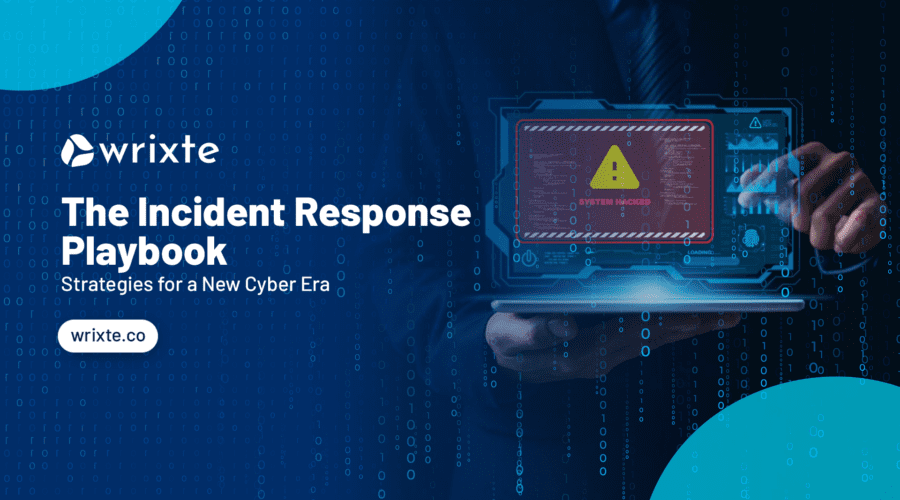In the dynamic and often tumultuous realm of cybersecurity, the importance of a robust and adaptive incident response playbook cannot be overstated. As we look deeper into the new cyber era, businesses and organizations face an ever-evolving array of cyber threats. From sophisticated ransomware attacks to intricate phishing schemes, the need for a comprehensive strategy to manage and mitigate these incidents is critical. This blog explores the cornerstone strategies of an effective incident response playbook, drawing upon the latest trends and insights to guide businesses in fortifying their defenses for the challenges ahead.
Where Does Cybersecurity Currently Stand?
Before we get into the strategies part, it’s crucial to understand the current cybersecurity landscape. According to a report by Cybersecurity Ventures, cybercrime is projected to inflict damages totaling $6 trillion globally in 2021, a figure that is expected to grow by 15 percent per year over the next five years. This staggering statistic underscores the urgent need for robust incident response mechanisms.
1. Preparation: The Keystone of Incident Response
Preparation is the foundation of any successful incident response playbook. This involves not only equipping your team with the necessary tools and technologies but also ensuring that they are well-versed in the latest cybersecurity practices. Regular training sessions, simulations, and drills can keep your team sharp and ready to act when a real incident occurs.
2. Identification: Rapid Detection is Key
The ability to quickly identify a security incident is paramount. Leveraging advanced detection technologies such as AI and machine learning can significantly enhance your capabilities in this area. For instance, AI-driven security systems can analyze patterns and detect anomalies that may indicate a breach, allowing for immediate action.
3. Containment: Limiting the Damage
Once an incident is detected, swift containment is essential to limit its impact. This may involve isolating affected systems, revoking access privileges, or deploying patches. The goal is to prevent the incident from spreading and causing further damage, a strategy that Wrixte emphasizes in its comprehensive incident response services.
4. Eradication: Removing the Threat
With the incident contained, the next step is to remove the threat from the affected systems. This could involve deleting malicious files, removing unauthorized users, or updating software to eliminate vulnerabilities. Eradication is a critical step in ensuring that the threat is completely neutralized.
5. Recovery: Restoring Systems and Trust
The recovery phase focuses on restoring affected systems and operations to their normal state. This involves careful planning and execution to ensure that no remnants of the threat remain. Additionally, this phase is crucial for restoring trust among stakeholders, emphasizing transparent communication about the incident and the measures taken to resolve it.
6. Lessons Learned: Turning Experience into Insight
Perhaps the most important aspect of any incident response playbook is the post-incident analysis. This involves a thorough review of the incident, the response, and the outcomes. The goal is to identify both strengths and areas for improvement, turning the experience into actionable insights for future incident response efforts.
Leveraging Advanced Technologies
Wrixte leverages the power of artificial intelligence (AI), machine learning, and automation to enhance the efficiency and effectiveness of incident response. By integrating these technologies, we offer swift identification and containment of threats, minimizing the window of opportunity for attackers. Our proactive threat hunting capabilities further enable the detection of sophisticated, previously unidentified threats, ensuring your organization stays one step ahead of cyber adversaries.
Customized Incident Response Playbooks
Understanding that each organization’s security system is unique, Wrixte specializes in developing customized incident response playbooks. These tailored playbooks are designed to align with your specific operational and business needs, ensuring a swift and coordinated response to incidents. Our team works closely with you to identify your critical assets and vulnerabilities, crafting a playbook that is both pragmatic and resilient.
Post-Incident Analysis and Continuous Improvement
The learning journey does not end with the resolution of an incident. Wrixte emphasizes the importance of post-incident analysis and continuous improvement. Our experts conduct thorough reviews to extract valuable lessons, refining and updating your incident response playbook to reflect new insights and evolving threats. This iterative process ensures your defenses remain robust and adaptive, safeguarding your organization against the uncertainties of the future.
Conclusion
In the face of an increasingly complex and dynamic cybersecurity world, the importance of a well-structured and adaptable incident response playbook cannot be underestimated. By partnering with Wrixte, you leverage not only our technological prowess and expertise but also a commitment to innovation and excellence in incident management. Together, we can navigate the challenges of the new cyber era, transforming incident response from a reactive measure into a proactive and predictive strategy. With Wrixte, you’re not just responding to incidents—you’re anticipating them, ready to defend your digital domain with precision and agility.
